Overview
Best practices for application data integration are crucial in today’s data-driven landscape. They focus on ensuring both security and efficiency through a comprehensive governance framework, modern tools, and proactive strategies.
Are you facing challenges in integrating your data securely? Implementing robust security measures, such as encryption and access controls, is essential. Furthermore, utilizing automation and real-time processing tools can help overcome these integration challenges.
By adopting these strategies, organizations can maintain a competitive edge. In conclusion, investing in a solid integration framework not only enhances security but also streamlines operations, driving your business forward.
Introduction
In the digital age, where data is often regarded as the new oil, the integration of disparate data sources has emerged as a cornerstone of effective decision-making for organizations. Application data integration not only streamlines operations but also enhances data quality, empowering businesses to dismantle silos and foster collaboration.
As companies increasingly modernize their data infrastructures, understanding the nuances of integration techniques—such as data consolidation, federation, and propagation—becomes critical. The urgency for effective strategies is escalating, particularly in light of technological advancements like generative AI.
Organizations must prioritize robust integration practices to maintain a competitive edge. This article explores the key concepts, challenges, and best practices surrounding data integration, providing valuable insights for navigating the complexities of today’s data landscape.
Understanding Application Data Integration: Key Concepts and Definitions
Application data integration is essential for merging details from diverse applications to create a cohesive view that supports informed decision-making. This integration employs various techniques, including consolidation, federation, and propagation, each playing a crucial role in modernizing information infrastructures and enhancing operational efficiency.
Information consolidation involves combining data from multiple sources into a single repository, streamlining access and analysis. In contrast, information federation allows entities to retain information in its original location while providing a unified perspective, thereby minimizing redundancy and enhancing information integrity. Propagation, on the other hand, refers to the distribution of information across systems to ensure consistency and availability.
Understanding these concepts is vital for organizations aiming to dismantle information silos and improve overall quality through application data integration. By integrating diverse information sources, businesses can enhance their decision-making processes, leading to more agile and informed strategies. Key elements of effective application data integration include information mapping, transformation, and the use of middleware to facilitate seamless communication between applications.
Recent trends indicate that by 2025, the demand for efficient information unification approaches is set to increase. A significant 37% of early adopters of generative AI report feeling ahead of their competitors, while only 11% of planners share this sentiment, underscoring the critical need for proactive integration efforts. Amani Undru, a BI & Data Strategist, emphasizes this urgency: “In contrast, just 11% of planners feel they are ahead of the competition, highlighting the urgency for them to take action.”
This disparity underscores the importance of application data integration in maintaining a competitive advantage in today’s fast-paced business landscape.
Moreover, the significance of application data integration and information federation cannot be overstated. These strategies not only streamline operations but also enhance security and compliance, particularly in sectors such as banking and healthcare, where data integrity is paramount. The hybrid connectivity platform ensures 24/7 availability for essential connections, further underscoring the reliability of connection solutions in these sensitive environments.
By maximizing and extending the value of legacy systems, Avato simplifies complex connections and significantly reduces costs, enabling organizations to achieve improved service delivery and customer satisfaction.
In summary, as companies navigate the complexities of contemporary operations, prioritizing application information unification will be crucial for attaining efficiency, security, and a competitive edge.
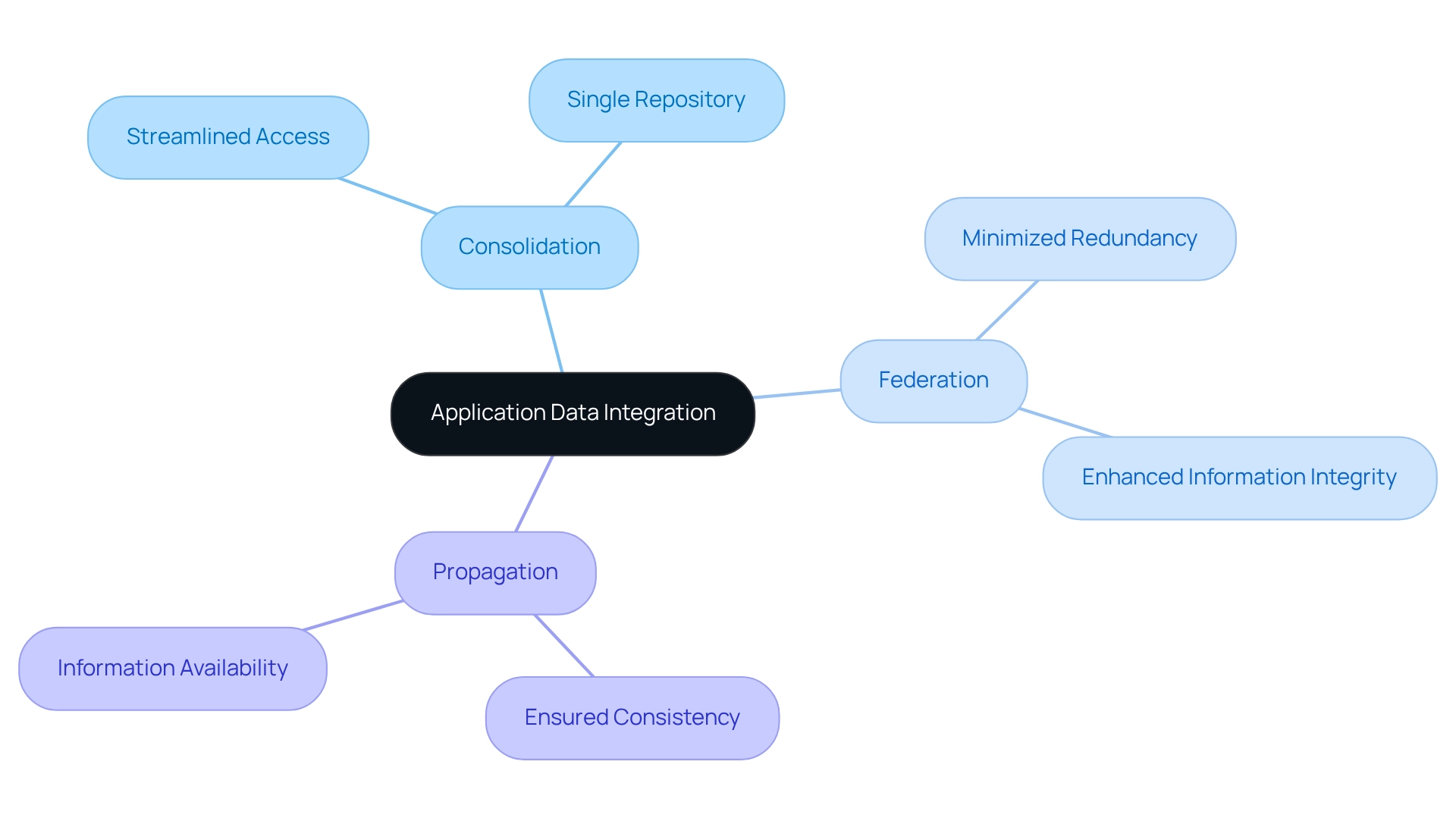
Prioritizing Security in Data Integration: Strategies and Considerations
To ensure robust security in information amalgamation, organizations must adopt a multi-layered approach encompassing encryption, access controls, and regular security evaluations. Avato’s secure hybrid integration platform is meticulously architected for secure transactions and designed to guarantee 24/7 uptime, establishing it as a trusted solution for banks, healthcare, and government sectors. Role-based access control is essential, as it restricts sensitive information access to authorized personnel only, thereby significantly reducing the risk of unauthorized exposure.
Furthermore, employing secure APIs and information masking methods provides an additional layer of protection during transit, ensuring that sensitive details remain safeguarded against potential breaches.
Regular updates to security protocols and conducting comprehensive vulnerability assessments are critical practices that enable organizations to identify and mitigate potential threats proactively. Adherence to regulations such as GDPR and HIPAA is not merely a legal obligation but a vital component of a robust governance framework, enhancing the overall security posture. Avato’s commitment to establishing a solid foundation for digital transformation underscores the importance of maintaining compliance and security in information amalgamation.
As the cybersecurity landscape continues to evolve, with the market projected to reach $212 billion by the end of 2025, organizations must remain vigilant. Notably, Gartner predicts that by 2025, 99% of cloud security failures will result from customer misconfigurations, highlighting the necessity for meticulous security practices. The banking and finance sector, which has observed a slight decrease in cyber attacks from 23% in 2020 to 18.2% in 2023, still faces significant risks, emphasizing the urgent need for effective cybersecurity strategies.
Recent incidents, such as the data breach at Financial Business and Consumer Solutions in February 2024, which exposed sensitive information of over 4 million individuals, further illustrate the critical importance of implementing strong security measures in data integration.
As Andrea Sugden, Chief Sales and Customer Relationship Officer at the company, emphasizes, ‘Let’s Talk To get started with a VikingCloud cybersecurity and compliance assessment, email, call or click: Contact Us.’ This call to action reinforces the necessity for entities to proactively evaluate their cybersecurity measures and ensure they are adequately safeguarded against evolving threats.
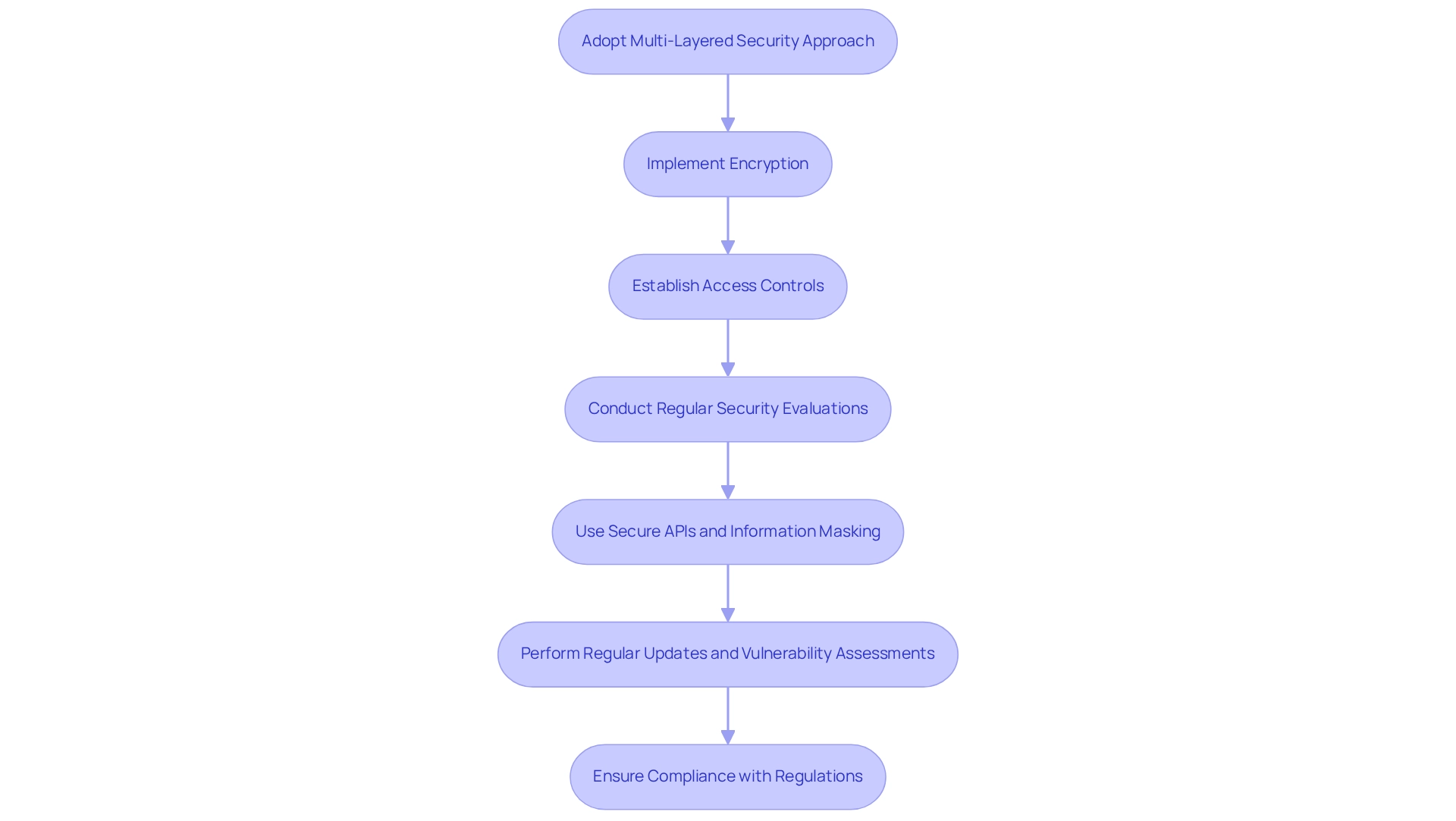
Enhancing Efficiency in Data Integration: Tools and Techniques
To significantly enhance efficiency in information merging, organizations must prioritize application data integration through modern unification platforms, such as Avato’s hybrid unification platform. This platform facilitates automation and real-time information processing. Avato’s platform is equipped with robust ETL (Extract, Transform, Load) and ELT (Extract, Load, Transform) tools, which are crucial for optimizing workflows and ensuring faster, more reliable information management. By 2025, the integration landscape is increasingly shifting towards cloud-based solutions, offering unmatched scalability and flexibility—essential for adapting to evolving business needs.
Moreover, implementing strong quality tools is vital to ensure that only accurate and relevant information is integrated, thereby minimizing the need for revisions and enhancing overall productivity. Techniques like information virtualization can further boost efficiency by providing a consolidated view of data without the need for physical movement, which can be resource-intensive.
Organizations adopting these contemporary unification strategies, particularly through Avato’s platform, have reported remarkable improvements in operational efficiency. For instance, companies leveraging cross-departmental information collaboration have experienced feature development cycles that are up to 45% faster. As Beate Thomsen, Co-founder & Product Design, succinctly states, the merging process should ‘keep it simple, functional yet beautiful.’
By focusing on these advanced unification methodologies, businesses can achieve application data integration that not only streamlines data processes but also drives strategic decision-making, ultimately maintaining a competitive edge in their markets.
When selecting a systems integrator, organizations should weigh three critical factors:
- Expertise in the chosen technology
- Industry-specific experience
- Project methodology
These elements are essential for a successful unification process, especially in the context of HRIS unification, where focusing on these factors enhances the likelihood of effective outcomes. The SaaS model of HR systems further guarantees scalability and accessibility, making it a crucial consideration for modern enterprises.
Avato’s dedication to crafting technology solutions that simplify diverse systems enhances its capability to empower businesses through seamless information and system unification, aligning with the five strategic methods to future-proof operations.
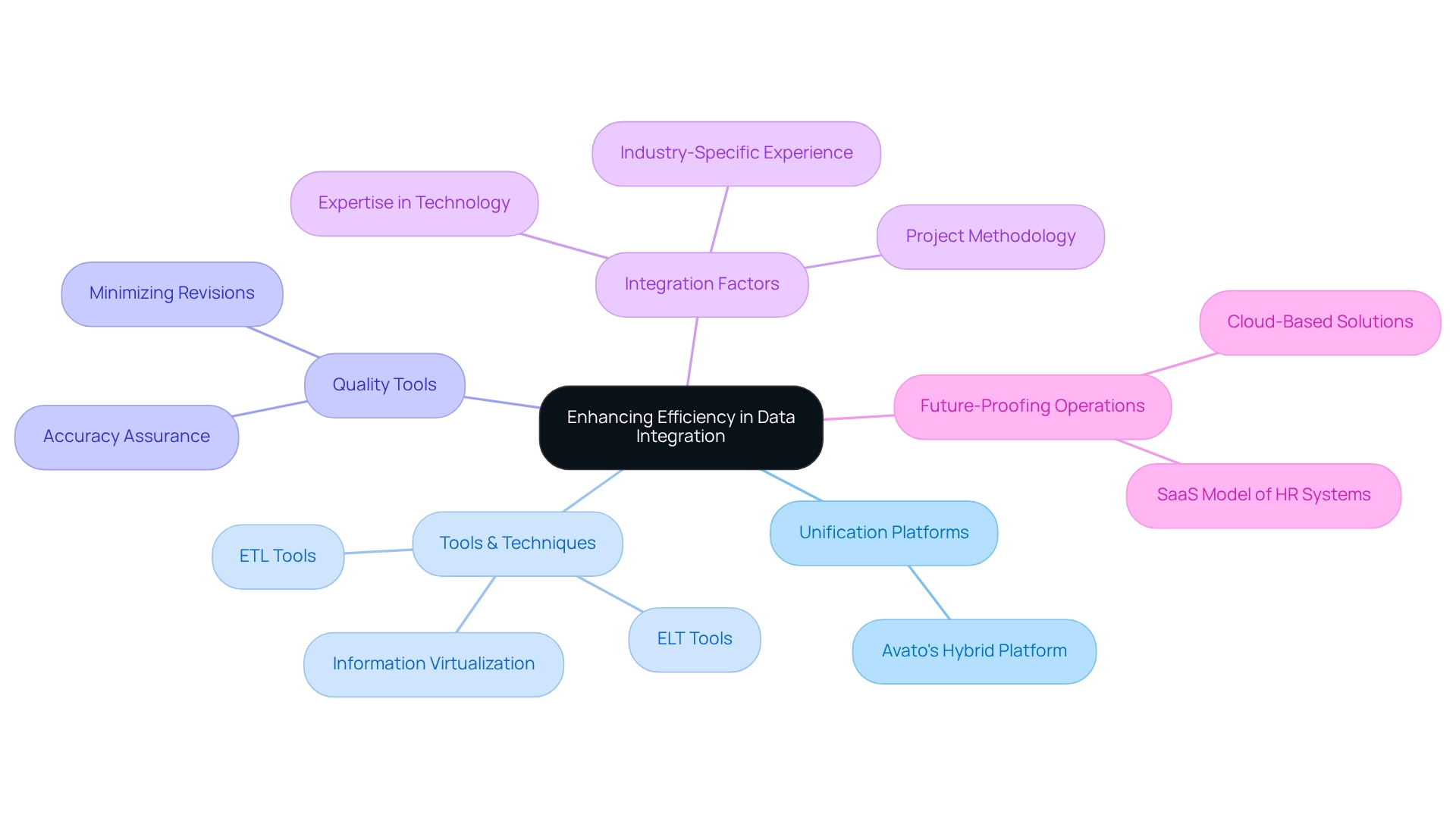
Navigating Challenges in Data Integration: Common Obstacles and Solutions
Organizations face a range of typical obstacles in application data integration, such as information silos, inconsistent formats, and compatibility issues with legacy systems. These challenges can significantly impede unification efforts, resulting in inefficiencies and heightened operational risks. To navigate these complexities effectively, a comprehensive evaluation of the current application data integration environment is essential prior to merging.
Avato, with its innovative hybrid connection platform, is dedicated to crafting solutions that tackle the merging obstacles associated with application data integration. Establishing robust governance policies is crucial for standardizing formats and ensuring quality across the organization. This approach not only mitigates the risks linked to information silos but also enhances the overall success rates of application data integration initiatives.
Statistics reveal that 27% of security and IT professionals identify alleviating internal audit fatigue as a primary compliance challenge, highlighting the importance of efficient information governance in unification strategies.
Furthermore, leveraging Avato’s middleware solutions can facilitate seamless communication through application data integration between legacy systems and modern applications, bridging the gap between diverse technologies. Educating personnel on integration best practices is another vital measure that can enhance collaboration and minimize errors throughout the integration process. As companies increasingly prioritize product integrations—83% regard them as a crucial factor for improving close rates—addressing these common challenges becomes imperative.
The fact that 35% of business and tech leaders consider third-party breaches to be one of the most pressing cyber threats underscores the necessity for rigorous due diligence and continuous monitoring to safeguard sensitive information.
Case studies illustrate effective strategies for overcoming information silos. For instance, organizations that have implemented comprehensive third-party risk management initiatives have reported a reduction in legal, financial, and reputational risks associated with information sharing. Despite the risks, many organizations acknowledge the significance of these programs, which are deemed essential for minimizing vulnerabilities.
By focusing on these typical difficulties and utilizing expert solutions offered by specialists, companies can enhance their application data integration efforts, ensuring both safety and efficiency in their operations. As Shivbhadrasinh Gohil noted, the global Big Data Analytics market was valued at $307.51 billion in 2023 and is projected to reach $924.39 billion by 2032, underscoring the growing importance of effective information merging strategies. Moreover, organizations can mobilize stakeholders to accurately capture requirements, employ the right technology and tools to illustrate current and ideal states, and model new business processes to chart a path to success, as detailed in Avato’s FAQs.
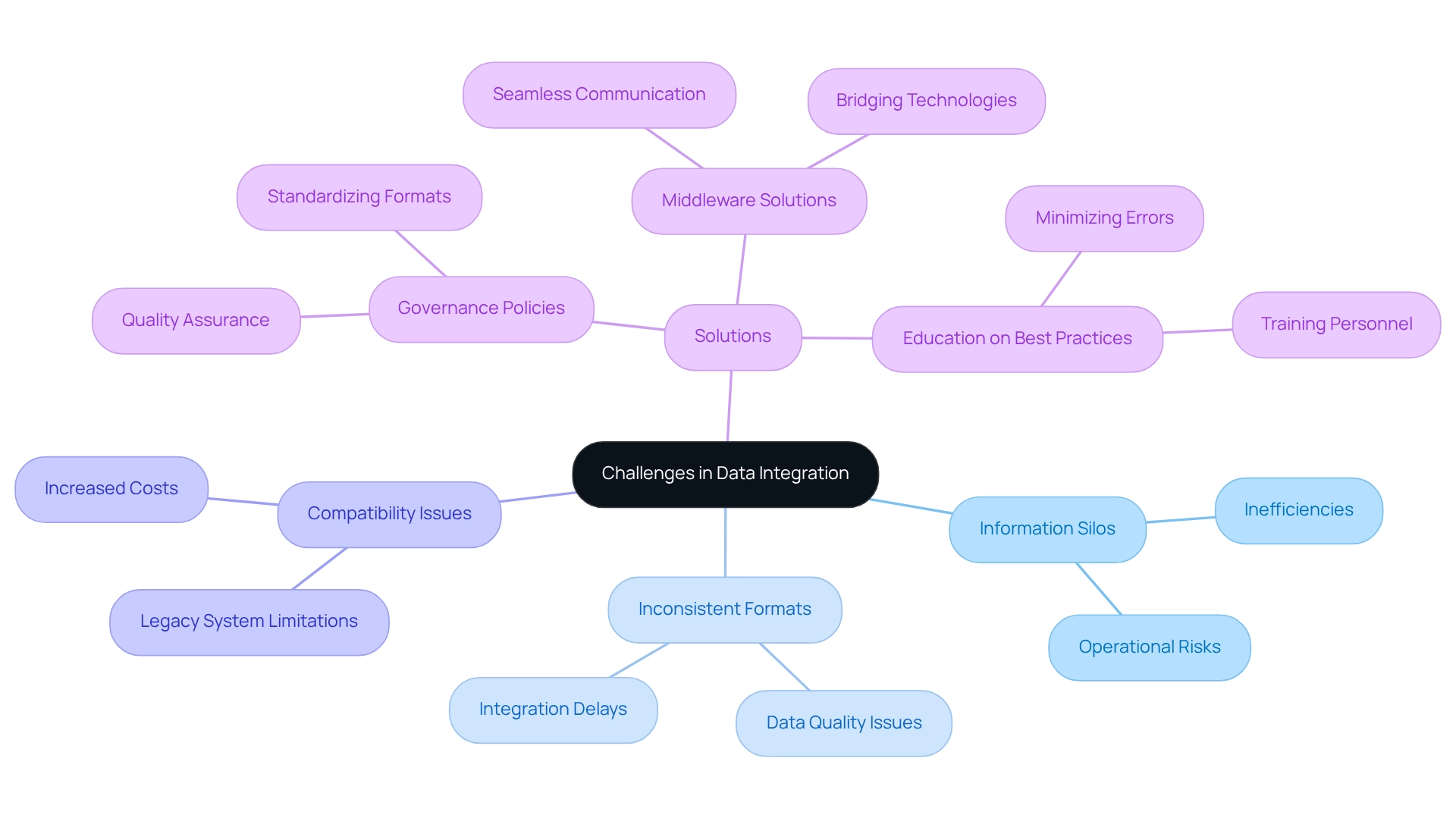
Ensuring Compliance in Data Integration: Best Practices for Regulated Industries
To achieve adherence in information integration, companies must establish a comprehensive governance framework that encompasses critical elements such as classification, access controls, and audit trails. This framework serves as the backbone for ensuring compliance with stringent regulations like GDPR, HIPAA, and PCI DSS. Regular compliance audits are essential; they provide a systematic approach to evaluating compliance levels and identifying areas for improvement.
Statistics reveal that a substantial portion of entities encounter compliance audit failures, underscoring the necessity for careful supervision in information management practices. Are your current practices robust enough to withstand scrutiny?
Furthermore, cultivating a culture of responsibility within organizations is essential. Alarmingly, 34% of employees do not report wrongdoing due to fear of retaliation from higher management. Establishing transparent retention policies that outline storage durations and suitable timelines for deletion not only supports regulatory compliance but also enhances information management efficiency. Training employees on compliance requirements and best practices is vital for fostering this culture.
By investing in extensive training programs and executing change management strategies, companies can equip their staff with the knowledge and tools required to handle compliance challenges. This proactive approach significantly reduces risks linked to data breaches and noncompliance, ultimately promoting a secure and effective data unification environment.
Additionally, appointing a C-level compliance leader can yield substantial financial advantages, with businesses saving an average of $1.25 million in compliance expenses. Organizations must also consider the challenges posed by third-party risk management, as highlighted in case studies on vendor risk management, which emphasize the importance of enhancing employee training and compliance measures. Furthermore, utilizing tools like those offered by Drata can automate compliance processes, ensuring audit readiness across various frameworks.
Lastly, it is concerning that in small entities, hotlines are only implemented in 25.7% of the cases studied, highlighting the urgent need for better reporting mechanisms in compliance frameworks.
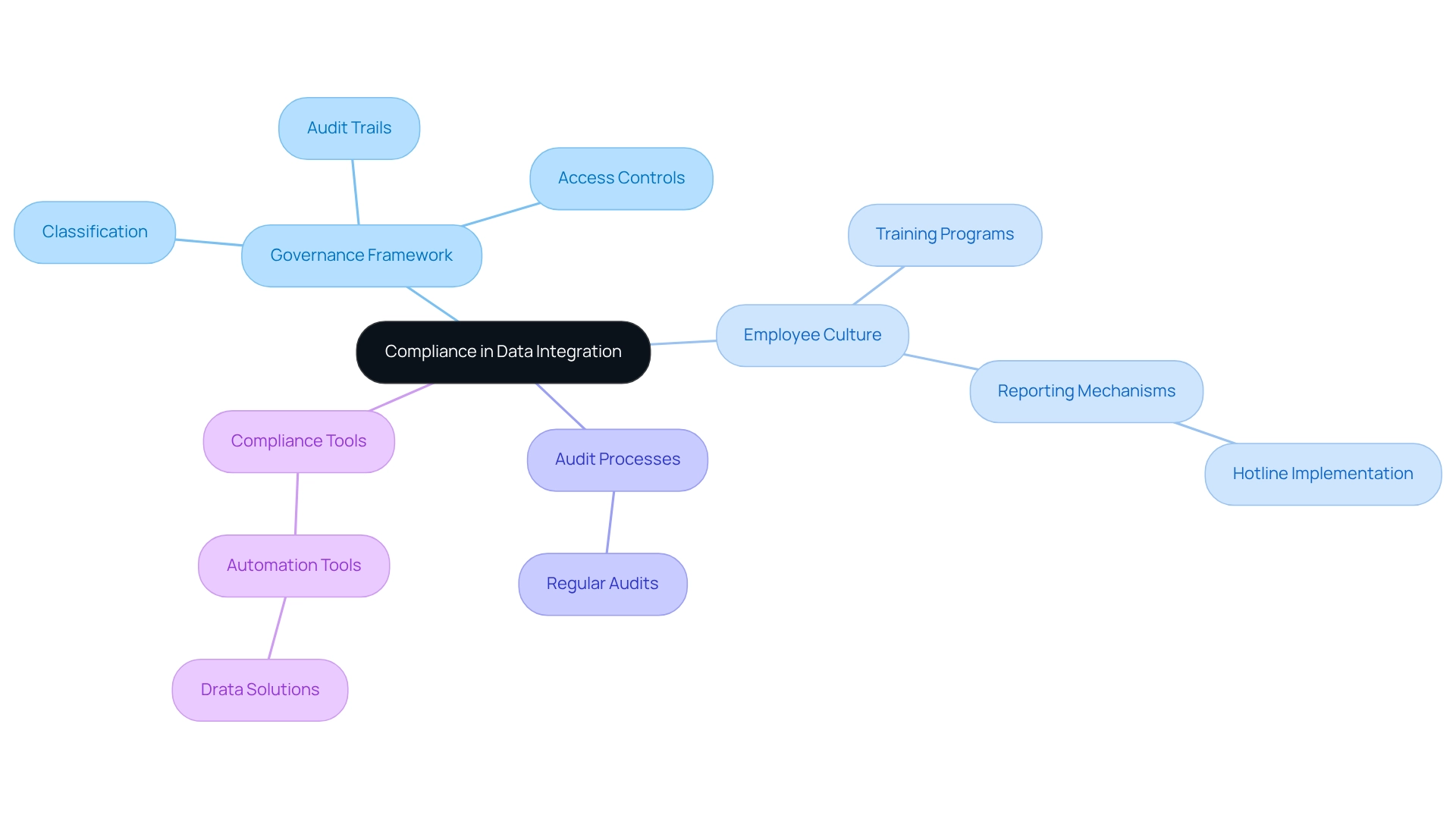
Integrating Legacy Systems: Strategies for Modernizing Data Infrastructure
Integrating legacy systems requires a well-defined strategy for application data integration that aligns modernization efforts with minimal disruption to ongoing operations. Organizations must start by thoroughly assessing their existing legacy systems, identifying critical functionalities that must be retained to ensure continuity. In 2025, implementing API-based integration stands out as a pivotal strategy, facilitating seamless communication between legacy systems and modern applications.
This approach not only enhances interoperability but also mitigates the risks associated with outdated technologies. Phased migration strategies prove especially effective, allowing entities to implement gradual updates that prevent overwhelming the existing infrastructure. This method significantly reduces the likelihood of downtime, which can be costly; organizations often allocate up to 75% of their IT budgets to maintaining outdated legacy systems. By adopting a gradual approach, businesses can update their systems while preserving operational stability, a process that Avato supports with its specialized hybrid connection platform designed for speed, security, and simplicity.
Furthermore, utilizing middleware solutions can effectively bridge legacy and modern systems, ensuring a smooth transfer of information across platforms. This unification layer is essential for synchronizing data and ensuring system performance, as highlighted in case studies that discuss the challenges of legacy system unification. These challenges encompass security risks, maintenance costs, and compatibility issues, all of which can escalate if not managed properly.
For instance, the company’s collaboration with financial institutions, such as Coast Capital, illustrates how its hybrid solutions have facilitated major system transitions with minimal downtime, showcasing the platform’s reliability and effectiveness. Experts underscore the importance of API-based connectivity for legacy systems, noting that it not only streamlines application data integration but also enhances overall operational capabilities. As Gustavo Estrada, a client, stated, “The company has streamlined intricate projects and provided outcomes within preferred time limits and financial constraints.” By prioritizing these strategies and leveraging unique offerings, organizations can navigate the complexities of legacy system unification and position themselves for future success.
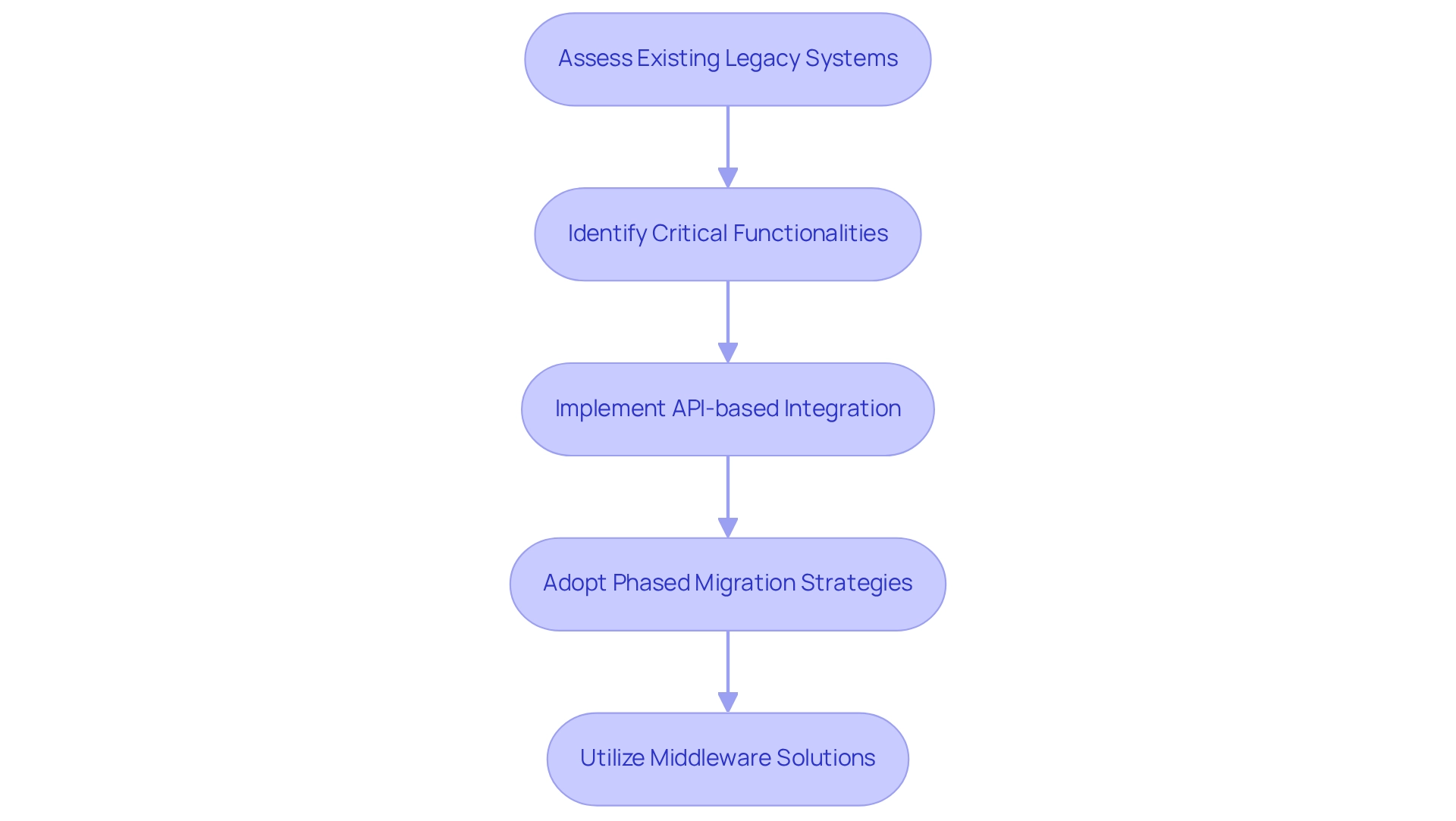
Case Studies in Data Integration: Success Stories and Lessons Learned
Case studies from organizations that have successfully executed information unification underscore the critical role of strategic planning and implementation. For instance, the partnership involving Coast Capital, which launched in February 2013, exemplifies how a leading bank enhanced its information accessibility by integrating various systems via a hybrid platform, resulting in a remarkable 30% reduction in retrieval times. This advancement not only streamlined operations but also accelerated decision-making processes, aligning with the trend of data-driven leadership that significantly enhances cost-efficiency and ROI.
As noted by Louis Columbus, “Enterprises significantly favor implementing information unification in the cloud by almost 2X compared to on-premise,” highlighting the growing preference for hybrid solutions.
In June 2016, the company facilitated the transition of Coast Capital’s entire telephone banking and contact center telephony system with merely a 63-second outage, demonstrating its commitment to reliability. In the healthcare sector, the collaboration with the Provincial Health Services Authority transformed patient information management through real-time information integration. This initiative not only improved patient care but also bolstered operational efficiency, illustrating the profound impact of effective data unification on organizational performance.
The company’s commitment to ensuring 24/7 availability for essential connections, supported by features designed for secure transactions, further emphasizes the reliability of hybrid connection platforms in enabling such initiatives.
Particular success stories from the company’s clients, such as Tony LeBlanc from the Provincial Health Services Authority, showcase the effectiveness of these strategies in both banking and healthcare sectors. These narratives highlight the importance of leveraging Avato’s hybrid connection platform to enhance information accessibility and retrieval times, ultimately leading to improved service delivery and increased satisfaction among stakeholders.
These examples illustrate that when organizations prioritize optimal methods of information integration, they can achieve substantial enhancements in productivity and effectiveness, paving the way for ongoing growth and innovation.
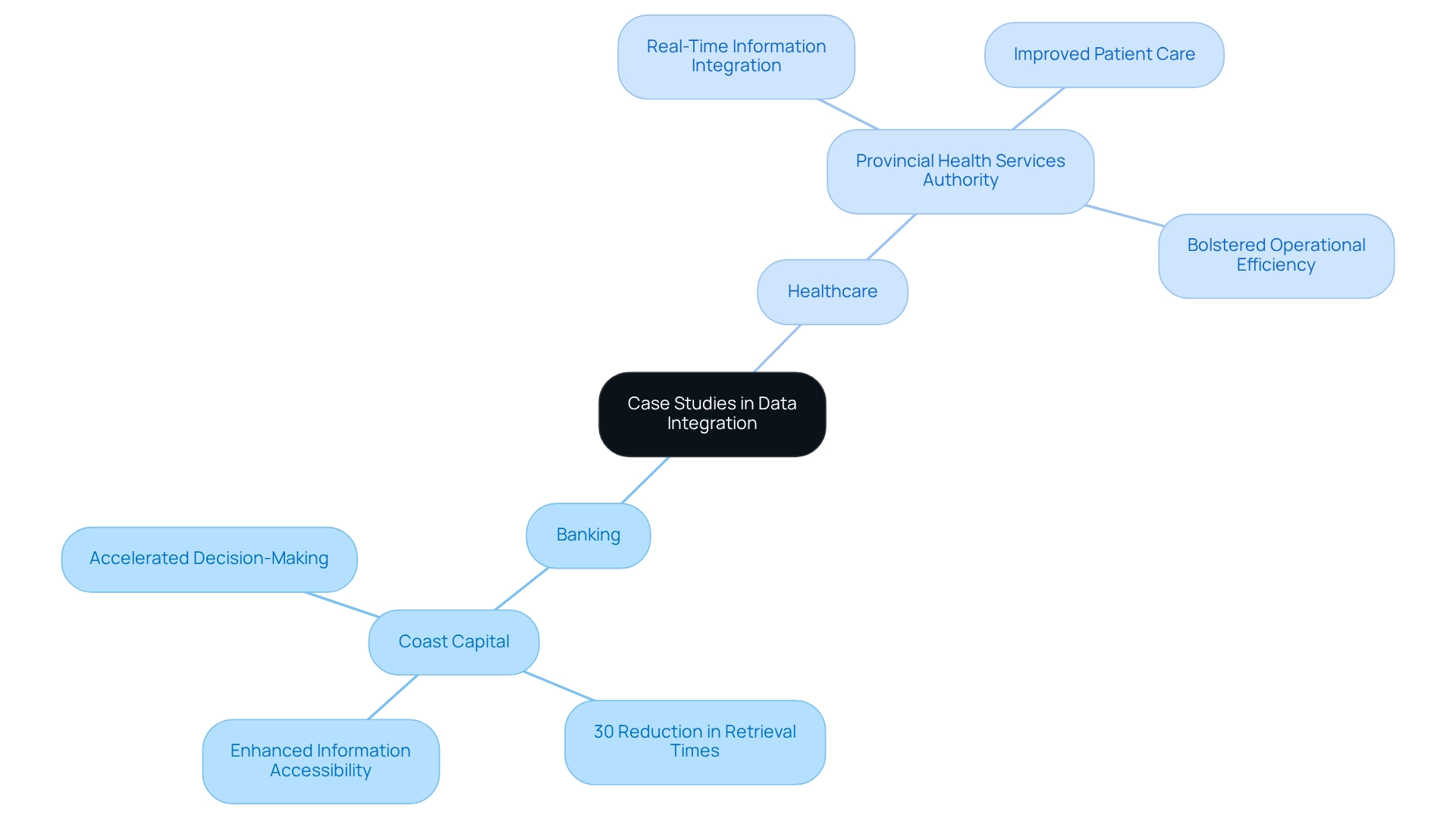
Key Takeaways: Implementing Best Practices for Effective Data Integration
To execute efficient application data integration practices, organizations must emphasize security and compliance while utilizing contemporary tools and methods to address the challenges presented by legacy systems. Key takeaways for successful data integration include:
-
Establish a Clear Information Governance Framework: A strong information governance framework is crucial for ensuring quality and compliance. This framework should outline roles, responsibilities, and processes for managing information assets efficiently, allowing entities to engage stakeholders and obtain requirements correctly on the first attempt. For practical steps, refer to our FAQs on how to effectively engage stakeholders and structure requirements.
-
Utilize Automation and Real-Time Processing Tools: Employing automation and real-time processing tools can significantly enhance efficiency in data consolidation efforts. These technologies enable organizations to streamline workflows and reduce manual errors, leading to faster and more reliable outcomes. Avato, for example, guarantees 24/7 availability for essential connections, highlighting the significance of dependability in these procedures and preparing systems to incorporate new tools with current resources.
-
Conduct Regular Assessments of Data Merging Strategies: Organizations should routinely evaluate their data merging strategies to identify areas for improvement. This proactive method enables the prompt modification of practices for application data integration to align with changing business requirements and technological progress, ensuring that unification strategies remain effective in a swiftly evolving environment.
-
Encourage a Culture of Cooperation and Development: Promoting teamwork among groups and offering continual training guarantees that staff possess the essential skills to handle unification challenges. This culture of collaboration is essential for the successful implementation of projects. As mentioned by Gustavo Estrada, Avato streamlines intricate projects and provides outcomes within specified timelines and budget limitations, emphasizing the efficiency of joint efforts in transforming business collaboration.
-
Prioritize Security and Compliance: Organizations must prioritize security and adherence in their information unification efforts, particularly in sectors like banking and healthcare, where sensitivity is paramount. Applying best practices in information governance can reduce risks and improve trust in integrated systems. According to the case study titled “Data Consolidation Best Practices,” defining clear business objectives and comprehending the information being combined are essential steps in addressing challenges of merging.
By following these best practices, companies can achieve smooth application data integration, propel digital transformation, and sustain a competitive advantage in their respective sectors. The application of these strategies not only guarantees high-quality information accessibility but also aids the overall business goals, as demonstrated by organizations that have successfully managed the challenges of information amalgamation.
Get your copy now: For more insights and resources, subscribe to the Avato Blog or download our comprehensive guide on data integration best practices.

Conclusion
Prioritizing application data integration is essential for organizations aiming to excel in today’s data-driven landscape. By grasping key concepts such as data consolidation, federation, and propagation, businesses can effectively dismantle silos and enhance data quality. This integration not only streamlines operations but also bolsters decision-making capabilities, ultimately fostering more agile strategies.
In light of the growing urgency for effective integration practices—especially with the rise of generative AI—organizations must implement robust security measures and compliance frameworks to protect sensitive information. A multi-layered security approach, which includes encryption and access controls, is vital for mitigating risks and ensuring data integrity across all operations.
Furthermore, leveraging modern integration tools and techniques can significantly boost efficiency. Utilizing platforms that facilitate automation and real-time data processing enables quicker, more reliable workflows while preserving operational stability during transitions from legacy systems. Case studies of organizations that have successfully adopted these strategies illustrate the tangible benefits of prioritizing data integration.
Ultimately, as businesses navigate the complexities of modern operations, embracing best practices in data integration will not only drive digital transformation but also position them for sustained growth and competitive advantage. By investing in effective integration strategies, organizations can ensure high-quality data availability, enhance collaboration, and cultivate a culture of continuous improvement, paving the way for future success.

